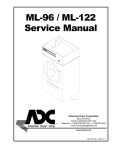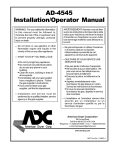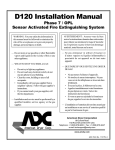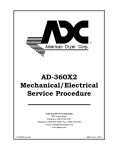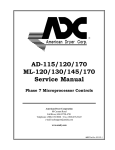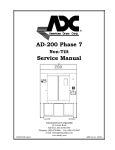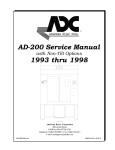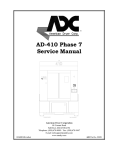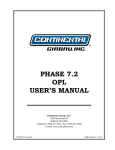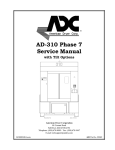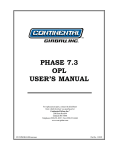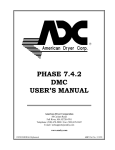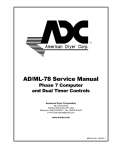Download ADC ML-190 Service manual
Transcript
ML-175 / ML-190 Service Manual Phase 6 / Phase 7 Microprocessor Controls American Dryer Corporation 88 Currant Road Fall River, MA 02720-4781 Telephone: (508) 678-9000 / Fax: (508) 678-9447 E-mail: [email protected] www.amdry.com ADC Part No. 450431-3 Retain This Manual in a Safe Place for Future Reference This product embodies advanced concepts in engineering, design, and safety. If this product is properly maintained, it will provide many years of safe, efficient, and trouble free operation. Only qualified technicians should service this equipment. OBSERVE ALL SAFETY PRECAUTIONS displayed on the equipment or specified in the installation manual included with the dryer. The following “FOR YOUR SAFETY” caution must be posted near the dryer in a prominent location. FOR YOUR SAFETY POUR VOTRE SÉCURITÉ Do not store or use gasoline or other flammable vapors and liquids in the vicinity of this or any other appliance. Ne pas entreposer ni utiliser d’essence ni d’autres vapeurs ou liquides inflammables à proximité de cet appareil ou de tout autre appareil. We have tried to make this manual as complete as possible and hope you will find it useful. The manufacturer reserves the right to make changes from time to time, without notice or obligation, in prices, specifications, colors, and material, and to change or discontinue models. The illustrations included in this manual may not depict your particular dryer exactly. IMPORTANT For your convenience, log the following information: DATE OF PURCHASE ________________________________________________ MODEL NO. _____________________ RESELLER’S NAME __________________________________________________________________________________ SERIAL NUMBER(S) __________________________________________________________________________________ ____________________________________________________________________________________________________ ____________________________________________________________________________________________________ Replacement parts can be obtained from your reseller or the ADC factory. When ordering replacement parts from the factory, you can FAX your order to ADC at +1 (508) 678-9447 or telephone your order directly to the ADC Parts Department at +1 (508) 678-9000. Please specify the dryer model number and serial number in addition to the description and part number, so that your order is processed accurately and promptly. “IMPORTANT NOTE TO PURCHASER” Information must be obtained from your local gas supplier on the instructions to be followed if the user smells gas. These instructions must be posted in a prominent location near the dryer. 2 American Dryer Corporation 450431 - 3 IMPORTANT You must disconnect and lockout the electric supply and the gas supply or the steam supply before any covers or guards are removed from the machine to allow access for cleaning, adjusting, installation, or testing of any equipment per OSHA standards. Table of Contents ________ Important Information ............................................. 4 Safety Precautions ............................................... 4 Routine Maintenance .............................................. 4 Cleaning ................................................................ 4 Adjustments ......................................................... 5 Please observe all safety precautions displayed on the equipment and/or specified in the installation manual included with the dryer. Lubrication ............................................................ 5 Installation Requirements ...................................... 5 Enclosure, Air Supply, and Exhaust Requirements ................................... 5 CAUTION Dryer(s) should never be left unattended while in operation. “Caution: Label all wires prior to disconnection when servicing controls. Wiring errors can cause improper operation.” «Attention: Au moment de l’entretien des commandes, étiquetez tous les fils avant de les débrancher. Des erreurs de câblage peuvent entraîner un fonctionnement inadéquat et dangereux.» WARNING Children should not be allowed to play on or near the dryer(s). Children should be supervised if near dryer(s) in operation. Under no circumstances should the dryer door switch(es), lint door/drawer switch(es), or heat safety circuit(s) ever be disabled. Electrical and Gas Requirements ......................... 6 Operational Service Check Procedure ................... 6 Description of Parts ................................................. 6 Servicing .................................................................10 Troubleshooting ...................................................... 20 Phase 6 OPL System Diagnostics ......................... 21 Diagnostic (L.E.D. Display) Failure Codes ...........21 L.E.D. Display Indicators ..................................... 22 Phase 6 OPL Microprocessor Controller (Computer) Relay Output L.E.D. Indicators .......... 23 Phase 7 OPL System Diagnostics ......................... 24 Diagnostic (L.E.D. Display) Failure Codes ...........24 Technical Information ............................................25 The dryer must never be operated with any of the back guards, outer tops, or service panels removed. Personal injury or fire could result. The dryer must never be operated without the lint filter/screen in place, even if an external lint collection system is used. FOR YOUR SAFETY Do not dry mop heads in the dryer. Do not use dryer in the presence of dry cleaning fumes. List of Acronyms _____________________ DSI Direct Spark Ignition HSI Hot Surface Ignition in wc Inches of Water Column The dryers must not be installed or stored in an area where it will be exposed to water and/or weather. L.E.D. Light Emitting Diode L.P. Liquid Propane OPL On-Premise Laundry (Non-Coin) The wiring diagram for the dryer is located in the front electrical control box area. OSHA Occupational Safety and Health Administration 450431 - 3 T.E.F.C. Totally Enclosed, Fan-Cooled www.amdry.com 3 Important Information ________________ ! WARNING ▲ Safety Precautions Do not store or use gasoline or other flammable vapors and liquids in the vicinity of this or any other appliance. Purchaser/user should consult the local gas supplier for proper instructions to be followed in the event the user smells gas. The instructions should be posted in a prominent location. Dryer must be exhausted to the outdoors. Although ADC’s dryer is a very versatile machine, there are some articles, that due to fabric composition or cleaning method, should not be dried in it. ! ▲ WARNING Dry only water-washed fabrics. Do not dry articles spotted or washed in dry cleaning solvents, a combustible detergent, or “all purpose” cleaners. Fire or explosion could result. Do not dry rags or articles coated with gasoline, kerosene, paint, or wax. Do not dry mop heads. Contamination by wax or flammable solvents will create a fire hazard. Do not use heat for drying articles that contain plastic, foam, sponge rubber, or similarly textured rubberlike materials. Drying in a heated tumbler may damage plastic or rubber and also may be a fire hazard. A program should be established for the inspection and cleaning of lint in the burner area and exhaust ductwork. The frequency of cleaning can best be determined from experience at each location. ! WARNING ▲ Articles left in the dryer after the drying and cooling cycles have been completed can create a fire hazard. This dryer is not to be used in the presence of dry cleaning solvents or fumes. Read and follow all caution and direction labels attached to the dryer. ! WARNING ▲ Children should not be allowed to play on or in the dryer(s). Children should be supervised if near dryer(s) in operation. Do not operate dryers with more than 125 psi (8.62 bar) steam pressure. Excessive steam pressure can damage steam coil and/or harm personnel. Replace leaking flexible steam hoses or other steam fixtures immediately. Do not operate dryer with leaking flexible hoses. Personal injury may result. Routine Maintenance _________________ Cleaning A program and/or schedule should be established for periodic inspection, cleaning, and removal of lint from various areas of the dryer, as well as throughout the ductwork system. The frequency of cleaning can best be determined from experience at each location. Maximum operating efficiency is dependent upon proper air circulation. The accumulation of lint can restrict this airflow. If the guidelines in this section are met, an ADC dryer will provide many years of efficient, trouble free, and – most importantly – safe operation. ! WARNING ▲ The collection of lint in the burner area and exhaust ductwork can create a potential fire hazard. For personal safety, the dryer must be electrically grounded in accordance with local codes and/or the National Electrical Code ANSI/NFPA No. 70-LATEST EDITION. NOTE: Failure to do so will void the warranty. Under no circumstances should the dryer door or lint drawer switch(es) or heat safety devices ever be disabled. ! WARNING ▲ Lint from most fabrics is highly combustible. The accumulation of lint can create a potential fire hazard. Keep dryer area clear and free from combustible materials, gasoline, and other flammable vapors and liquids. NOTE: Suggested time intervals shown for average usage, which is considered six to eight operational (running) hours per day. Clean lint drawer/screen every third or fourth load. Personal injury or fire could result. NOTE: Frequency can best be determined at each location. Articles should never be left unattended for an extended period of time in the tumbler after completion of the drying and cooling cycles. 4 American Dryer Corporation 450431 - 3 Daily Adjustments (Beginning) of each work shift. 7 Days After Installation and Every 6 Months Clean lint from the drawer/screen. Inspect lint screen and replace if torn. Inspect bolts, nuts, screws, (bearing setscrews), nonpermanent gas connections (unions, shutoff valves, orifices, and grounding connections). Motor and drive belts should be examined. Cracked or seriously frayed belts should be replaced. Tighten loose V-belts when necessary. Complete operational check of controls and valves. Complete operational check of all safety devices (door switch, lint drawer switch, sail switch, burner and hi-limit thermostats). Weekly Clean lint accumulation from lint chamber, thermostat, and microprocessor temperature sensor (sensor bracket) area. ! WARNING ▲ Lubrication To avoid the hazard of electrical shock, discontinue electrical supply to dryer. Steam Dryers Clean steam coil fins using compressed air and a vacuum cleaner with brush attachment. NOTE: When cleaning steam coil fins, be careful not to bend the fins. If fins are bent, straighten by using a fin comb, which is available from local air-conditioning supply houses. 90 Days Remove lint from tumbler, drive motors, and surrounding areas. Remove lint from gas valve burner area with a dusting brush or vacuum cleaner attachment. NOTE: To prevent damage, avoid cleaning and/or touching ignitor/flame-probe assembly. Remove lint accumulation from inside control box and at rear area behind control box. 6 Months Inspect and remove lint accumulation in customer furnished exhaust ductwork system and from dryer’s internal exhaust ducting. ! WARNING ▲ The accumulation of lint in the exhaust ductwork can create a potential fire hazard. Do not obstruct the flow of combustion and ventilation air. Check customer furnished back draft damper in exhaust ductwork. Inspect and remove any lint accumulation, which can cause damper to bind or stick. NOTE: A back draft damper that is sticking partially closed can result in slow drying and shut down of the heat circuit safety switches or thermostats. When cleaning dryer cabinet(s), avoid using harsh abrasives. A product intended for the cleaning of appliances is recommended. 450431 - 3 The fan shaft bearings should be lubricated every three months. Use Shell Alvania #2 or its equivalent. The motor bearings, idler bearings and under normal/most conditions the tumbler bearings are permanently lubricated. It is physically possible to re-lubricate the tumbler bearings if you choose to do so even though this practice is not necessary. Use Shell Alvania #2 or its equivalent. The tumbler bearings used in the dryer do not have a grease fitting. Provisions are made in the bearing housing for the addition of a grease fitting, which can be obtained elsewhere, or from ADC by ordering kit P/N 882159, which includes two fittings. Installation Requirements ____________ Installation should be performed by competent technicians in accordance with local and state codes. In the absence of these codes, the installation must conform to applicable American National Standards: ANSI Z223.1-LATEST EDITION (National Fuel Gas Code) or ANSI/NFPA NO. 70LATEST EDITION (National Electrical Code) or in Canada, the installation must conform to applicable Canadian Standards: CAN/CGA-B149.1-M91 (Natural Gas) or CAN/ CGA-B149.2-M91 (L.P. Gas) or LATEST EDITION (for General Installation and Gas Plumbing) or Canadian Electrical Codes Parts 1 & 2 CSA C22.1-1990 or LATEST EDITION (for Electrical Connections). Enclosure, Air Supply, and Exhaust Requirements NOTE: The following information is very brief and general. For detailed description, refer to the “ML-175 Installation Manual” (ADC P/N 113070). Bulkheads and partitions around the dryer should be made of noncombustible materials. Allowances should be made for the opening and closing of the control door and lint drawer. Also, allowances should be made in the rear for ease of maintenance. (Refer to appropriate Installation Manual for recommended distances and minimum allowances required.) When the dryer is operating, it draws in room air, heats it, passes this air through the tumbler, and exhausts it out of the building. Therefore, the room air must be continually replenished from the outdoors. If the make-up air is inadequate, drying time and drying efficiency will be adversely affected. Ignition problems and sail switch “fluttering” problems on gas dryers may result, and you also could have premature motor failure from overheating. The air supply must be given careful consideration to ensure proper performance of each dryer. www.amdry.com 5 IMPORTANT: Make-up air must be provided from a source free of dry cleaning fumes. Make-up air that is contaminated by dry cleaning fumes will result in irreparable damage to motors and other dryer components. Operational Service Check Procedure Exhaust ductwork should be designed and installed by a competent technician. Improperly sized ductwork will create excessive back pressure, which will result in slow drying, increased use of energy, and shut down of the burner by the airflow (sail) switch, burner hi-limit or lint chamber hi-heat protector thermostat. (Refer to appropriate Installation Manual for more details.) Press “E” on the keypad of microprocessor controller (computer). ! CAUTION: Improperly sized or installed exhaust ductwork can create a potential fire hazard. Compressed Air Requirements The dryer requires an external supply of air (2.5 cfm @ 80 psi [0.07 cmm @ 5.52 bar) on the steam models, the air is necessary to operate the damper system. On both steam, as well as the gas model, the air is necessary/required for the blower air jet operation to clean lint from the impellor/ fan (squirrel cage type). Turn on electric power to the dryer. To start dryer: Display will read “READY.” The dryer will start to run. NOTE: Pressing keypad “A,” “B,” “C,” “D,” or “F” will also start the dryer. Six preprogrammed drying cycles (“A” through “F”) have been stored in the computer’s memory. (Refer to Computer Operator’s Manual for details.) Make a complete operational check of all the operating controls to assure that the timing is correct, temperature selection switches are functioning, etc. Make a complete operational check of all safety-related circuits: door switch(es), hi-limit thermostat, sail switch, cycling thermostats, etc. For gas dryers, a gas pressure test should be taken at the gas valve pressure tap of each dryer to assure that the water column pressure is correct and consistent. NOTE: Water column pressure requirements (measured at the pressure tap on the gas valve body): Natural Gas – 3.5 in wc; L.P. Gas – 10.5 in wc Electrical and Gas Requirements It is your responsibility to have all electrical connections made by a properly licensed and competent electrician to assure that the electrical installation is adequate and conforms to local and state regulations or codes. In the absence of such codes, all electrical connections, materials, and workmanship must conform to the applicable requirements of the National Electrical Code ANSI/NFPA NO. 70-LATEST EDITION or in Canada, the Canadian Electrical Codes Parts 1 & 2 CSA C22.1-1990 or LATEST EDITION. IMPORTANT: Failure to comply with these codes or ordinances and/or the requirements stipulated in this manual can result in personal injury or component failure. The dryer installation must meet the American National Standard, National Fuel Gas Code ANSI Z223.1-LATEST EDITION, or in Canada, the Canadian Electrical Codes Parts 1 & 2 CSA C22.1-1990 or LATEST EDITION (for Electrical Connections) as well as, local codes and ordinances, and must be done by a qualified technician. NOTE: Undersized gas piping will result in ignition problems and slow drying and can create a safety hazard. The dryer must be connected to the type of gas (natural or L.P.) indicated on the dryer data label. If this information does not agree with the type of gas available, contact the reseller who sold the dryer or contact the factory. If computer program changes are required, refer to the Phase 6 OPL Operator’s Manual (ADC P/N 113022) for details. The dryer should be operated through one complete cycle to assure that no further adjustments are necessary and that all components are functioning properly. Check the electric service phase sequence. While the dryer is operating, check to see if the tumbler is rotating in the proper direction. Looking from the front, the tumbler should spin in the clockwise direction. If so, the phasing is correct. If the phasing is incorrect, reverse two leads at connections L1, L2, or L3 of power supply to the dryer. Description of Parts __________________ Control Panel (Microprocessor) Opening the control panel will allow access to the major components, which include the computer board and keypad. The keypad inputs to the computer what temperature and program has been selected. The computer controls the entire operation of the machine. It accepts inputs and gives outputs to various parts throughout the machine. The gas input ratings shown on the dryer data label are for elevations up to 2,000 feet (610 meters), unless elevation requirements of over 2,000 feet (610 meters) were specified at the time the dryer order was placed with the factory. The adjustment for dryers in the field for elevations over 2,000 feet (610 meters) are made by changing the burner orifices. If this adjustment is necessary, contact the reseller who sold the dryer or contact the factory. NOTE: Any burner changes must be made by a qualified technician. 6 American Dryer Corporation 450431 - 3 Reversing Relay Panel Gas Burner Assembly Lifting the control door will reveal the reversing relay box. Located on the back of the relay box is the reversing relay panel. Included on this panel is a 4-position terminal block, blower overload, blower contactor, reversing contactor, 24 VAC transformer, fuse or circuit breaker, ground lug, and possibly an arc suppressor board. Gas heated dryers are equipped with a gas burner assembly consisting of four burner tubes, gas valve, ignitor, flameprobe, sail switch, and hi-limit thermostat. The inlet piping enters through the rear of the dryer on the left-hand side (viewing from the front) and runs to the front of the dryer where the gas valve is located. Drive Motor The T.E.F.C. drive motor is located in the right front hand corner of the dryer. It sits on an adjustable base so that the motor can be easily adjusted to the left or right. Steam Coil and Damper System The steam coil is constantly charged, thereby eliminating repeated expansion and contraction and also provide instant heating to start the drying process. The steam damper, located on top of the steam coil, is the only temperature controlling device in this system. When the steam damper is open, ambient air is drawn through the coil providing heat to the dryer. When the steam damper is closed, ambient air is drawn directly into the tumbler, bypassing the coil, allowing a rapid cool down. Blower Motor and Impellor (Gas and Steam) The impellor is shaft driven. The blower motor drives the shaft on which the impellor is mounted. NOTE: With the dryer off or no air supply to the damper piston, the damper is in the cool down mode. Steam Coil pH Level NOTE: The normal pH level for copper type steam coils must be maintained between a value of 8.5 to 9.5. For steel type steam coils the pH level must be maintained between a value of 9.5 to 10.5. These limits are set to limit the acid attack of the steam coils. IMPORTANT: Coil failure due to improper pH level will void the warranty. 450431 - 3 www.amdry.com 7 Idler Shaft Assembly Tumbler Shaft Support The idler shaft is located on the left side of the machine and is just above the blower motor. The idler shaft assembly consists of one 11-inch (27.94 cm) drive wheel and two pillow block bearings. The tumbler shaft support is located in the rear, approximately at the center of the dryer. The arrangement consists of a tumbler shaft support bracket, two high impact wheels, tumbler adjustment plate, Teflon® discs, and a rotational sensor assembly. Speed Reducing Shaft The speed reducing shaft is located on the right side and is above the drive motor. The idler assembly consists of two idler pulleys. The idler’s main purpose is to reduce the speed and increase torque provided to the tumbler. Rotational Sensor Assembly The rotational sensor assembly is located in the rear of the dryer. It consists of a magnet and rotational sensor switch, which is mounted to the bearing cap. The magnet is screwed to the shaft. The magnetic rotational sensor switch senses the rotation of the tumbler. Tumbler The tumbler consists of four ribs and four perforated panels, along with a front and back, which are welded together as an assembly. The tumbler also consists of a trunnion, which supports the tumbler in the rear. Drive Shaft The drive shaft is located on the right side and is above the drive motor. The drive shaft consists of one 11-inch (27.94 cm) drive wheel, one pulley, and two pillow block bearings. The purpose of the drive shaft is to drive the tumbler. 8 American Dryer Corporation 450431 - 3 Main Door Switch Burner Hi-Limit (Gas Models Only) The main door switch is located near the main door hinge. When the main door opens, the switch will also open, preventing the dryer from operating. The main door switch is a safety device and should never be disabled. A burner hi-limit thermostat is located on the burner. This is a manual reset disc-type thermostat set at 330° F (165° C). If the flame in the burner should get too hot, this thermostat will shut off the burner. This is generally caused by low airflow through the dryer. Tumbler Hi-Limit This is located in the lint compartment above the lint drawer. This bracket consists of two devices. One is a temperature sensor probe and the other is a hi-limit thermostat, which is set at 225° F (107° C). Sail Switch (Gas Models Only) The sail switch is located on the front of the burner box. A sail switch consists of a round damper plate on a lever arm, which is in contact with an electric switch. When the fan/ blower comes on, it draws air through the burner box. This creates a negative pressure inside the burner box, and this negative pressure pulls in the round damper and activates the sail switch. 450431 - 3 www.amdry.com 9 Lint Drawer Servicing ______________________________ The lint drawer is located at the bottom of the dryer in the lint compartment. Simply grab the lint drawer handle, slide out the drawer, brush off the lint, and slide the drawer back in. Introduction All electrical/mechanical service or repairs should be made with the electrical power to the dryer disconnected (power off). ! WARNING ▲ Personal injury could result. The information provided in this section should not be misconstrued as a device for use by an untrained person making repairs. Service work should be performed by competent technicians in accordance with local, state, and federal codes. When contacting the factory for assistance, always have the dryer model and serial numbers available. ! CAUTION: Observe all safety precautions displayed on the dryer or specified in this manual before and while making repairs. Before considering replacement, make sure that all connectors are in place and making proper contact. Lint Drawer Switch The lint drawer switch is located in the lint compartment and attached to the side of the lint drawer track. The lint drawer switch ensures that the dryer will operate only when the lint drawer is completely closed. This is a safety device and should never be disabled. Computer Controls To Replace Computer Disconnect electrical power to the dryer. Disconnect main power harness, along with the three other connectors located on the computer board, from rear of computer by squeezing locking tab and pulling connector straight back. Disconnect the “green” ground wire and the air jet wire from the computer. Disconnect keypad ribbon from the computer. Remove the screws securing the computer to the sheet metal control panel. Remove the board by pulling the other two corners off the clinch studs. Install new computer by reversing this procedure. When replacing the computer, the “A” and “B” factors must be reprogrammed. (Refer to “Computer Operator’s Manual” for details.) NOTE: The “A” and “B” factors are printed on a label located on the rear of the control panel (refer to illustration). Reestablish electrical power to the dryer. 10 American Dryer Corporation 450431 - 3 Disconnect the two “orange” wires from the high heat (225° F [107° C]) thermostat, and remove modular bracket connector, wires, and probe from bracket assembly. To Replace Keypad Label Assembly Discontinue electrical power to the dryer. Unplug keypad ribbon from rear of computer. Slowly peel off and remove keypad label assembly from control panel. Install new sensor probe assembly (ADC P/N 880251) by reversing procedure. Reestablish electrical power to the dryer. Peel paper backing off new keypad label assembly. Holding the new keypad label assembly close to the panel, insert the keypad ribbon through the rectangular slot in the control panel. Align label assembly into position by matching the red viewing window on the label to the rectangular cutout in the panel and gently press into place. NOTE: If, when power is reestablished, the computer display reads “Temp Sensor Check Temp Sensor Fuse,” check for a loose connection in the wiring. Connect keypad ribbon to the computer. To Remove HSI Ignitor Reestablish electrical power to the dryer. Discontinue electrical power to the dryer. Ignition Controls Disconnect the two “white” ignitor wires going to the HSI module. Disassemble HSI ignitor from burner by removing the selftapping screw. Reverse procedure for installing new ignitor. To Replace Microprocessor Temperature Sensor Probe Discontinue electrical power to the dryer. Remove lint drawer. Remove six screws securing lint door and remove lint door. Remove microprocessor sensor bracket assembly from dryer. To Remove HSI Flame-Probe Assembly Discontinue electrical power to the dryer. Disconnect the “red” wire from the flame sensor probe, which goes to S2 on the HSI module. Disassemble flame sensor probe from burner by removing the self-tapping screw. Reverse procedure for installation of new flame sensor probe. To Replace Spark Ignitor and Flame-Probe Discontinue power to the dryer. Disconnect high voltage connector and flame-probe connection from ignitor. Disassemble ignitor from burner by removing the two self-tapping screws. Reverse procedure for installing the new ignitor probe. Disconnect sensor bracket harness connector. Remove the four Hex head screws securing bracket assembly to dryer and remove bracket from dryer. Disassemble sensor probe from bracket assembly by removing the top push-on fastener securing the probe from bracket. Use a small screwdriver to slowly pry the fastener off. 450431 - 3 NOTE: Before reestablishing power to the dryer, visually check the following: (refer to the illustration on the next page). www.amdry.com 11 To Test and Adjust Gas (Water Column) Pressure There are two types of devices commonly used to measure water column pressure. They are spring/mechanical-type gauges and manometers. The spring/mechanical-type gauge is not recommended, because it is easily damaged and not always accurate. A manometer is simply a glass or transparent plastic tube with a scale in inches. When filled with water and pressure applied, the water in the tube rises showing the exact water column pressure. NOTE: Manometers are available from the factory by ordering ADC P/N 122804. To Test Gas Water Column Pressure: Connect water column test gauge connection to gas valve pressure tap (1/8” N.P.T.). This pressure tap is located on the outlet (manifold) side of the valve. Start dryer. With burner on, the correct water column reading in inches would be: Natural Gas – 3.5 in wc; L.P. Gas – 10.5 in wc To Replace Gas Valve (Refer to burner illustration on the next page) Discontinue electrical power to the dryer. To Adjust Water Column Pressure (natural gas only, L.P. gas must be regulated at source): Close shutoff valve(s) in gas supply line. Remove the slotted vent cap on the top of the valve. Disconnect gas valve wiring. Turn the slotted adjustment screw, located on the top of the valve next to the terminals clockwise to increase manifold pressure and counterclockwise to decrease. NOTE: Identify location of each wire for correct reinstallation. Break union connection before gas valve. Loosen and remove screws (4) securing pipe brackets to burner. NOTE: If correct water column pressure cannot be achieved, problem may be due to an undersized gas supply line, a faulty or underrated gas meter, etc. Remove gas valve/manifold assembly from dryer. Remove valve mounting bracket, manifold, and piping from gas valve. Reverse procedure for installing new gas valve. ! WARNING ▲ Test all connections for leaks by brushing on a soapy water solution. Never test for leaks with a flame!!! To Replace Main Burner Orifices Refer to “To Replace Gas Valve” and follow the steps until manifold is removed then unscrew main burner orifices and replace. NOTE: Use extreme care when removing and replacing orifices. These orifices are made of brass and are easily damaged. Reversing the removal procedure for reinstalling. ! WARNING ▲ Test all connections for leaks by brushing on a soapy water solution. Never test for leaks with a flame!!! 12 American Dryer Corporation 450431 - 3 ! WARNING ▲ To Convert from Natural Gas to L.P. Gas NOTE: All dryers are sold as natural gas, unless otherwise specified at the time the dryer order was placed. For L.P. gas the dryer must be converted as follows. Remove the four screws which secure the top cap assembly. This assembly contains the regulator adjustment screw and the terminal connections. Replace the top cap assembly with the L.P. version. To install the new L.P. orifices refer to “Replace Main Burner Orifices”. Test all connections for leaks by brushing on a soapy water solution. Never test for leaks with a flame!!! To Replace HSI Module / DSI Module Discontinue electrical power to the dryer. Remove the wires connected to the terminal strip at the bottom of the module. NOTE: Use extreme care when removing and replacing orifices. These orifices are made of brass and are easily damaged. Remove the two pal nuts securing the module to the mounting bracket. Reverse the procedure for reinstalling valve assembly to the dryer. Reestablish electrical power to the dryer. Replace module by reversing procedure. ! WARNING ▲ Test all connections for leaks by brushing on a soapy water solution. Never test for leaks with a flame!!! NOTE: There is no regulator provided in an L.P. dryer. The column pressure must be regulated at the source (L.P. tank) or an external regulator must be added to each dryer. To Replace Burner Tubes Refer to “Replace Gas Valve” and follow the instructions up to “Remove gas valve/manifold assembly from dryer”. Remove four screws securing manifold rest and remove rest. Remove the screws securing the front flanges of the burner tubes to the burner tube rest. Remove the screws securing the burner tube rest to the oven and remove this rest. Thermostats To Replace Burner Hi-Limit Thermostat (Gas Models Only) IMPORTANT: Under no circumstances should heat circuit safety devices ever be disabled. Remove screws securing the burner box cover plate to the oven and remove this plate. Remove burner tubes by sliding them out. Replace by reversing procedure. Discontinue electrical power to the dryer. Disconnect wires from hi-limit thermostat. Remove screw, washer, and nut securing thermostat to the bracket. Remove thermostat. 450431 - 3 www.amdry.com 13 Reverse procedure for installing new thermostat. To Adjust Sail Switch Reestablish electrical power to the dryer. With the dryer operating at a high temperature setting, pull the sail switch away from the burner. The sail switch should open and extinguish the burner. Let the sail switch damper return to the burner wall. The sail switch should close to restart the burner ignition cycle. If the sail switch circuit does not operate as described, bend the actuator arm of the sail switch accordingly until proper operation is achieved. To check proper “open” position of sail switch, open main door, manually depress main door switch, and start dryer. With the main door open and the dryer operating, the sail switch should be open, and the burner should not come on. To Replace Lint Compartment Hi-Heat Protector (225° F [107° C) Thermostat IMPORTANT: Under no circumstances should heat safety devices be disabled. IMPORTANT: Under no circumstances should heat safety devices be disabled. Front Panel and Main Door Assemblies To Replace Main Door Switch Discontinue electrical power to the dryer. Open main door. Remove the two Phillips head screws holding the main door switch bracket assembly in place. Remove door switch bracket and disconnect wiring from switch. Disassemble door switch from bracket by removing the two #6-32 nuts. Remove door switch from bracket. Discontinue electrical power to the dryer. Reverse this procedure for installing new door switch. Remove lint drawer. Remove two screws securing lint door and remove lint door. Locate sensor bracket assembly and the four Hex head screws securing bracket assembly to the tumbler wrapper. Disconnect sensor bracket harness connector and remove bracket assembly from dryer. Disconnect the two “orange” wires from the thermostat. Disassemble thermostat from bracket assembly by removing the two mounting screws, washers, and nuts. Reverse this procedure for installing a hi-heat protector thermostat. Reestablish electrical power to the dryer. NOTE: This is a manual reset thermostat. Before changing the thermostat make sure the reset button is in to determine if the thermostat has failed. Sail Switch Assembly (Gas Models Only) To Replace Sail Switch Disconnect electrical power to the dryer. Reestablish electrical power to the dryer. Remove the two screws which hold sail switch box cover to sail switch box. Disconnect the two wires from the switch. IMPORTANT: Under no circumstances should the door switch be disabled. Disassemble sail switch from mounting bracket by removing the two screws securing switch in place. To Replace Main Door Assembly Reverse this procedure for installing new sail switch. Adjust sail switch as described in the next section. Remove two Allen head screws holding the top main door hinge block to the front panel. Remove the main door by lifting up and off of bottom hinge block. Reverse this procedure for reinstalling new main door assembly. 14 American Dryer Corporation 450431 - 3 To Install New Main Door Glass Remove main door assembly from dryer (follow main door removal procedure). Lay main door on flat surface with front of door face up. Remove the twelve Phillips head screws securing front panel to dryer. Pull wires up through front panel door switch wire channel and gently remove front panel assembly. Reverse this procedure for installing new front panel. Remove the four #10-32 Acorn nuts. Remove glass and clean all old sealant off main door. This area must be completely cleaned for correct bonding. Apply a narrow bead of silicone (ADC P/N 170730) all around main door area where glass will rest. Install glass onto door/adhesive and slightly press glass in place. Reestablish electrical power to the dryer. Pulleys To Replace Drive Shaft Pulleys Discontinue electrical power to the dryer. Remove the lint drawer. Remove the lint door. Remove right lint coop wall. Loosen V-belts, then rotate pulley and roll V-belts out of its’ grooves. Remove cap screws from the bushings. Insert cap screws in tapped removal holes and tighten evenly until bushing becomes loose on shaft. Refer to figure “A.” Remove bushing, pulley, and key. Assemble bushing and sheave as shown in figure “B”. When cap screws are loosely inserted, bushing remains fully expanded to provide a sliding fit on the shaft. Insert key on the shaft, then slide sheave to desired position with cap screw heads to the outside. IMPORTANT: Do not press hard or silicone thickness between the glass and door will be reduced, resulting in poor bonding. Secure the four #10-32 Acorn nuts to hold the glass. The door assembly should now be put in an area where it will not be disturbed for at least 24 hours. Depending on the conditions, the curing time of this adhesive is 24 to 36 hours. After 24-hour curing period, install main door on dryer by reversing the first step. To Replace Front Panel Discontinue electrical power to the dryer. Remove main door switch and bracket assembly. Follow procedure for removal of main door assembly. Open control (service) door. Remove lint drawer and open lint door by removing six screws. Unplug the door switch wires at the bottom of the front panel. Disconnect the wires connecting the “EMERGENCY STOP” (E-Stop). The easiest place to do this would be in the left hand electrical box. Once the wires are disconnected, push them through the inner top. Tighten cap screws progressively. There should remain a gap between the sheave hub and the flange of the bushing. 450431 - 3 www.amdry.com 15 IMPORTANT: Tighten screws evenly and progressively. Never allow the sheave to be drawn in contact with the flange of the bushing. This gap should measure from 1/8” to 1/4”. Proper cap screw torque is 30 ft.-lb. If greater tightening forces are applied, excess pressures will be created in the hub of the mounted sheave, which may cause it to crack. To Replace Motor Pulley Discontinue electrical power to the dryer. Remove the lint drawer. Remove the lint door. Loosen V-belts, then rotate pulley and roll V-belts out of its’ grooves. Remove cap screws from bushing. Tighten the two bolts under the drive shaft clockwise to raise the tumbler and counterclockwise to lower the tumbler. The bolts should be tightened in even increments in order to ensure that the shaft runs parallel with the base of the dryer. IMPORTANT: Side to side adjustment of the tumbler should be equal on either side of the front panel, but vertically the top of the tumbler should have a larger gap than the bottom to compensate for the load. Be sure to tighten the left idler side to the same height as the right side/drive side. This length can be determined by taking measurements from the bottom of each pillow block bearing to the top of the bearing pad. Insert cap screws in tapped removal holes and tighten evenly until bushing becomes loose on shaft. Refer to figure “A” on the previous page. NOTE: If the axle height is not the same on the drive and idler side, then the tumbler will be either more to the right or left side, depending on which axle is higher. Tighten locking nuts on the adjustment bolts. Reverse the first five steps for reassembly. Remove bushing, pulley, and key. Assemble bushing and sheave as shown in figure “B” on the previous page. When cap screws are loosely inserted, bushing remains fully expanded to provide a sliding fit on the shaft. Insert key on the shaft, then slide sheave to desired position with cap screw heads to the outside. Tighten cap screws progressively. There should remain a gap between the sheave hub and the flange of the bushing. Check tumbler drive belt for proper tension. Adjust if necessary. Reestablish electrical power to the dryer. Bearings To Replace Drive/Idler Shaft Pillow Block Bearings Discontinue electrical power to the dryer. Remove the lint drawer. IMPORTANT: Tighten screws evenly and progressively. Never allow the sheave to be drawn in contact with the flange of the bushing. This gap should measure from 1/8” to 1/4”. Proper cap screw torque is 6 ft.-lb., if greater tightening forces are applied, excess pressures will be created in the hub of the mounted sheave, which may cause it to crack. Tumbler Alignment Remove the lint door. Loosen and roll V-belts off that connect speed reducing shaft to drive shaft. Place a piece of wood between the tumbler and wrapper to support the tumbler when shaft is removed. Remove the four bolts holding the drive shaft assembly in the dryer. Remove cap screws from bushing of drive wheel. Discontinue electrical power to the dryer. Remove the lint drawer. Insert cap screws in tapped removal holes and tighten evenly until bushing becomes loose on shaft. Remove the lint door. Remove bushing and key. Remove both the left hand and right hand lint coop walls. Remove wheel from shaft. Loosen the V-belts on drive shaft, then rotate pulley and roll V-belts out of its’ grooves. Loosen the four setscrews in the pillow block bearings. 16 American Dryer Corporation 450431 - 3 To Replace Rear Tumbler Shaft Support Wheels Disconnect electrical power to the dryer. Remove the four nuts securing the rear support box to the dryer. Remove the center Allen head bolt and Teflon® washer. Loosen the individual wheel bolts so the rear of the box can be removed. Remove the damaged wheel. Replace with new wheel. Reverse steps to replace support box. Reestablish electrical power to the dryer. Clean the shaft and slide the pillow block bearings off of the shaft. NOTE: Don’t over tighten wheel bolts, which could bind bearings. Reverse these steps to install new pillow block bearings. NOTE: Check belt adjustment and readjust if necessary. To Replace Speed Reducing Shaft Bearings Discontinue electrical power to the dryer. Remove the lint drawer. Remove the lint door. Loosen and roll V-belts off that connect speed reducing shaft to drive shaft. Loosen and roll V-belts off that connect speed reducing shaft to the drive motor. Rotational Sensor Switch Replacement Discontinue electrical power to the dryer. Remove the bearing cap from the dryer. Remove the adjustment nut from the bearing cap. Remove the magnetic rotational sensor switch from the bearing cap. Depress the tabs on the rotational sensor harness plug and pull apart, then remove the sensor switch. To install a new sensor switch, connect the plug of the new sensor switch to the sensor harness. Place one adjustment nut onto the sensor switch and insert into the bearing cap. Remove the four bolts holding the two speed reducing shaft pillow block bearings in place and remove shaft assembly from dryer. Place the second adjustment nut on but do not tighten. The magnet on the flange bearing and the sensor switch must be in a horizontal line to one another. To remove front or rear pulley follow steps in “To Replace Drive Shaft Pulleys”. The gap between the magnet and the sensor switch must be 1/8-inch. Loosen and remove the two setscrews in the front/rear pillow block bearing. Tighten the adjustment nuts installed. Reestablish electrical power to the dryer. Clean the shaft and slide the bearings off of the shaft. Install new bearing by reversing these procedures. Reestablish electrical power to the dryer. 450431 - 3 www.amdry.com 17 Basket and Support V-Belt Replacement (Drive Shaft To Speed Reducing Shaft) To Replace Tumbler and Tumbler Support Discontinue electrical power to the dryer. Discontinue electrical power to the dryer. Follow procedure for removal of main door assembly. Follow procedure for removal of front panel assembly. Remove the lint drawer. Remove the lint door. Loosen two bolts securing rear pillow block bearing on the drive shaft. Remove bearing back guard. To remove tumbler assembly and support, loosen the two setscrews on flange bearing models or remove the Allen head bolt and Teflon® washer on models with shaft support wheels. Remove the retaining ring from the groove of the tumbler shaft. Remove the rotational sensor magnet from the tumbler support shaft. Loosen adjustment bolt that is securing the rear pillow block bearing of the drive shaft. Loosen two bolts securing rear speed reducing shaft bearing. Loosen adjustment bolt supplying pressure to the rear bearing on the speed reducing shaft. Remove old V-belts. Reverse these steps to install new V-belts. NOTE: After tensioning the V-belts, check to make sure both the drive shaft and speed reducing are parallel or level to the base of the dryer. V-Belt Replacement (Motor To Speed Reducing Shaft) Discontinue electrical power to the dryer. Remove the lint drawer. Remove the lint door. Loosen two bolts securing front bearing on speed reducing shaft. Loosen tension bolt that is under the front bearing of the speed reducing shaft. Remove the V-belts. Remove the tumbler and support assembly from the front of the dryer. If the tumbler cannot be removed freely, clean the shaft area and spray WD-40 or similar lubricant. With a block of wood against the shaft end, strike the block of wood with a hammer or mallet to move the shaft past any burrs made by the setscrews. Replace V-belts by reversing the above procedures. IMPORTANT: Never strike the shaft directly with a hammer. Loosen the tension bolts. Reverse these steps for installation of new tumbler and tumbler support. Reverse these steps to replace V-belts. V-Belt Replacement (From The Blower Motor To The Fan) Loosen the four bolts securing the motor to the base of the dryer. Remove old V-belts. NOTE: Always replace V-belts in pairs. Reestablish electrical power to the dryer. Motors V-Belts To Replace Drive Motor (See illustrations in “Pulleys” section) V-Belts should have proper tension. If the pulleys are not properly aligned, excessive belt wear will result. Proper belt tension will allow 1/2” displacement under normal thumb pressure at mid span of belt. NOTE: Belts must always be replaced in pairs (matched sets). Discontinue electrical power to the dryer. Remove the lint drawer. Remove the lint door. Remove the left lint wall. Remove the drive V-belts. Follow V-belt replacement from motor to speed reducing shaft. Loosen the four bolts securing the motor to the base of the dryer. Disconnect the motor wiring. 18 American Dryer Corporation 450431 - 3 Remove old motor pulley and bushing and place on new motor. Follow “To Replace Motor Pulley”. Reverse these steps to replace drive motor. Loosen the four bolts securing the fan shaft assembly to the base of the dryer. NOTE: Models with rear access, it may be easier to remove this plate, to remove the two rear fan shaft assembly bolts. Remove the fan assembly through front access hole. Loosen the setscrews in each bearing. Loosen the four flange bolts and two pillow block bolts. Using a pulley, remove the bearing needing replacing. Reverse the procedures to reinstall new bearing. Impellor Discontinue electrical power to the dryer. Remove the left side lint wall if necessary for easier access. Remove the six nuts securing the inlet cone to the blower housing. To Replace Impellor Motor (Fan Shaft Drive – 50/60 Hz Gas and Steam Models) Remove the two left-handed jam nuts that hold the impellor to the fan shaft. Discontinue electrical power to the dryer. Remove the impellor, washers, and the key. Remove the lint drawer. Replace the impellor, key, washers, left-handed jam nuts, and the side panel. Reestablish electrical power to the dryer. Lint Drawer Assembly To Replace Lint Screen Pull out lint drawer. Remove lint screen from lint drawer. Drop new lint screen in place. Slide lint drawer back into dryer. Remove the lint door. Remove the left hand lint wall. Loosen the four mounting bolts securing the motor. Loosen the tension bolts. Remove V-belts. Disconnect motor wiring. Remove the motor pulley and bushing. Reverse these steps for installation of new motor. To Replace Fan Shaft and/or Fan Shaft Bearings To remove from the front, follow the instructions from “To Replace Impellor Motor”. Remove the two left-handed jam nuts that hold the impellor to the fan shaft. Remove the impellor, washers, and the key. 450431 - 3 www.amdry.com 19 To Replace Lint Drawer Switch No L.E.D. display on microprocessor controller (computer)... Disconnect electrical power to the dryer. Open circuit breaker switch or blown fuse. Remove lint drawer and lint door. Disconnect both 4-pin connectors at the rear of the lint switch cover. Remove the one or two screws holding the lint switch cover on. Tripped blower motor overload. Faulty wiring connection. Faulty transformer. “Emergency Stop” (E-Stop) button is depressed. Remove lint switch cover and disconnect the two terminals of the switch. Faulty microprocessor controller (computer). Remove switch by pressing tabs together and push switch out. Computer will not accept keypad entries... Keypad ribbon is not plugged into computer securely. Install new switch by reversing procedure. Faulty keypad. Faulty microprocessor controller (computer). Dryer will not start, but computer L.E.D. indicators are on... Failed contactors. Failed arc suppressor board. Failed microprocessor controller (computer). Failed motors. Blower motor runs, burner is on, but tumbler will not turn... Broken, damaged or loose V-belt. Damaged or misadjusted drive wheels. Loose or broken pulley. Troubleshooting ______________________ IMPORTANT: You must disconnect and lockout the electric supply and the gas supply or the steam supply before any covers or guards are removed from the machine to allow access for cleaning, adjusting, installation, or testing of any equipment per OSHA standards. Dryer operates but is taking too long to dry... Improperly programmed microprocessor controller (computer). An inadequate exhaust ductwork system. Restriction in exhaust system. Insufficient make-up air. Dirty or clogged lint screen. The information provided will help isolate the most probable component(s) associated with the difficulty described. The experienced technician realizes, however, that a loose connection or broken/shorted wire may be at fault where electrical components are concerned...and not necessarily the suspected component itself. Washing machine extractors are not performing properly. IMPORTANT: When replacing blown fuses, the replacement must be of the exact rating as the fuse being replaced. The information provided should not be misconstrued as a handbook for use by an untrained person in making repairs. Failed microprocessor controller (computer). The supply gas may have a low heating value, check with local gas supplier. Failed temperature sensor (temperature calibration is incorrect). Thermal overload for drive motor is tripping... Either an exceptionally low or high voltage supply. Motor bearing failure. ! WARNING ▲ Motor vents are blocked with lint. Failed motor. All service and troubleshooting should be performed by a qualified professional or service agency. Failed overload. Insufficient make-up air. While making repairs, observe all safety precautions displayed on the dryer or specified in this manual. 20 American Dryer Corporation 450431 - 3 Phase 6 OPL System Diagnostics ___ Overload for impellor (fan) motor is tripping... Either an exceptionally low or high voltage supply. IMPORTANT: You must disconnect and lockout the electric supply and the gas supply or the steam supply before any covers or guards are removed from the machine to allow access for cleaning, adjusting, installation, or testing of any equipment per OSHA standards. Motor bearing failure. Motor vents are blocked with lint. Failed motor. Failed overload. Out of balance impellor (fan). Insufficient make-up air. Burner hi-limit safety thermostat is tripping... Insufficient exhaust ductwork, size or restriction in exhaust system. Insufficient make-up air. Diagnostic (L.E.D. Display) Failure Codes Lint screen needs cleaning. Damaged impellor. L.E.D. display reads “Temp Sensor Failure Check Temp Sensor Fuse.” or “Open Exhaust Temperature Probe.”... Check 1/8-amp fuse on microprocessor controller (computer). (Phase 6 units only.) Faulty microprocessor controller (computer) temperature sensor probe. Open circuit or short in either one of two wires leading from the sensor probe to the computer... Faulty microprocessor controller (computer). Dryer does not start. Display reads “main door” or “lint door” with an audio indication... Main door is open. Lint drawer is open. Faulty main door or lint door switch. Open circuit in either main door or lint drawer switch harnesses. Faulty 24 VAC transformer. There is excessive vibration coming from the tumbler... Tumbler is out of adjustment. Drive shaft or idler shaft is out of alignment. Faulty pillow block bearing or 4-inch (10.16 cm) rear wheel. Faulty tumbler wheel. Drive motor and shaft not aligned. All major circuits, including door, microprocessor temperature sensor, heat and motor circuits are monitored. The Phase 6 OPL microprocessor controller (computer) will inform the user, via the L.E.D. display of certain failure codes, along with indicators both in L.E.D. display and at the output of each relay (and door switch circuit) to easily identify failures. SAIL SWITCH FAIL – This routine will prevent start up on the machine unless the sail switch is in the correct position. If the sail switch is closed prior to start up the display will read “SAIL SWITCH FAIL” along with an audio indication. No AIRFLOW – If the sail switch opens during cycle operation the display will read “No AIRFLOW” along with an audio indication. The machine will continue to run with no heat for 3 minutes or until the temperature drops below 100º F (38º C). Upon failure the machine will shut down and display “No AIRFLOW” with an audio indication. bURNER SAFETY FAIL – Routine monitors the temperature above the burner. If the burner hi-limit switch opens the display will read “bURNER SAFETY FAIL.” The machine will run with no heat for 3 minutes or until the temperature drops below 100º F (38º C). Upon failure the machine will shut down and display “bURNER SAFETY FAIL” with an audio indication. dRUM SAFETY FAIL – This routine monitors the tumbler temperature if the tumbler hi-limit switch opens prior or during the cycle while the heat was on the machine will display “dRUM SAFETY FAIL.” The machine will continue to run with no heat for 3 minutes or until the temperature drops below 100º F (38º C). Upon failure the machine will shut down and display “dRUM SAFETY FAIL” with an audio indication. No HEAT – This routine monitors the burner ignition. If the burner misignites (does not light) the ignition module will check to see of the microprocessor program has any retries left. The standard retry count is 2. If the module notices that there are retries left it will purge for 1 minute then try to ignite the burner again. The ignition module will try this for a total of 3 times or until there are no retries left. If the burner does not ignite after 3 attempts the L.E.D. display will display the error code “no heat” with an audio indication. When this occurs the machine will run with no heat for 3 minutes or until the temperature drops below 100º F (38º C). IMPORTANT: For other countries, such as Australia, the retry count may not apply due to local approvals. 450431 - 3 www.amdry.com 21 bURNER CONTROL FAIL – This routine monitors the ignition control’s gas valve output response. If the valve output signal is not present from the ignition control within the valve time limits the Phase 6 microprocessor controller (computer) determines the ignition control has failed. If this occurs when the cycle is active the machine will display “bURNER CONTROL FAIL.” If the tumbler temperature is above 100º F (38º C) the machine will continue to display “bURNER CONTROL FAIL.” The machine will run with no heat for 3 minutes or until the temperature drops below 100º F (38º C). If the tumbler temperature is below 100º F (38º C) upon failure the machine will shut down and display “bURNER CONTROL FAIL” with an audio indication. bURNER FLAME FAIL – This routine allows 2 flame out retries to occur before proceeding into the error. The count of 2 will be established every time the call for heat was to occur. Only if it reaches the count of 2 before the tumbler temperature has reached the set temperature will this error be triggered. The machine will run with no heat for 3 minutes or until the temperature drops below 100º F (38º C). If the tumbler temperature is below 100º F (38º C) upon failure, the machine will shut down and display “bURNER FLAME FAIL” with an audio indication. This process will occur every time the heat output is active. MAIN DOOR – This monitors the door circuit. If the machine was not active and the main door was opened the display would read “REAdY.” If a program attempt was made with the main doors open the display will read “MAIN dOOR” with an audio indication. If the machine is active and the main door was opened the display would read “MAIN dOOR” with no audio indication and the dryer will shut down. Once the main door has closed the display would read “PRESS START” press the “ENTER/START” key and it will continue the programmed cycle. LINT dOOR – This monitors the lint drawer and door circuit. If the machine was not active and the lint drawer and door was opened the display would read “REAdY.” If a program attempt was made with the lint drawer and door open the display would read “LINT dOOR” with an audio indication. If the machine is active and the lint drawer and door was opened the display would read “LINT dOOR” with no audio indication and the dryer will shut down. Once the lint door was closed the display would read “PRESS START” press the “ENTER/START” key and it will continue the programmed cycle. TEMP SENSOR FAIL CHECK TEMP SENSOR FUSE – This routine monitors the tumbler temperature. When the temperature sensor or fuse opens with the machine not active the display will read “TEMP SENSOR FAIL CHECK TEMP SENSOR FUSE” with an audio indication. If the machine was active at the time that the temperature sensor or fuse opened the display would read “TEMP SENSOR FAIL CHECK TEMP SENSOR FUSE.” The display will continue to read “TEMP SENSOR FAIL CHECK TEMP SENSOR FUSE” an audio indication will sound for approximately 5-seconds, every 30-seconds until the problem is corrected or the power to the dryer is disconnected (and the problem is corrected). NOTE: Once the Phase 6 microprocessor controller (computer) detects a problem in the heat circuit, it updates every 30-seconds, so that if the problem was a loose connection in the circuit, which corrected itself, the “TEMP SENSOR FAIL CHECK TEMP SENSOR FUSE” condition would automatically be cancelled and the display will return to “REAdY.” 22 ROTATE SENSOR FAIL – Indicates a rotational sensor circuit failure meaning that there is a fault somewhere in the tumbler rotating circuit, or the Phase 6 OPL microprocessor controller (computer) program related to this circuit (program location 2) is set incorrectly. In the active mode it should be (ROTATE SENSOR ACTIVE), if the dryer is not equipped with the optional rotational sensor it should be set in the nonactive mode (No ROTATE SENSOR). NOTE: RPM – This routine monitors the timing response from the existing rotational sensor input and derives a RPM measurement. To display this RPM measurement (press the “ENTER/START” key once and release, then press the “ENTER/START” key a second time and hold. This will display the RPM measurement). The rotational sensor must be active for operation of this feature. CHECK MAIN FUSE – Indicates that the circuit fuse protection, which is located on the back side of the Phase 6 microprocessor controller (computer) the display would read “CHECK MAIN FUSE.” If the display continues after the fuse has been replaced then it is the fault of the Phase 6 microprocessor controller (computer). L.E.D. Display Indicators The L.E.D. indicator dots located on the top portion of the display indicate the various Phase 6 OPL computer output functions while a cycle is in progress. These indicator dots (as shown in the illustration below) do not necessarily mean that the outputs are functioning. They are only indicating that the function output should be active (on). L.E.D. Display Indicator Number 1 For Optional Reversing Models: This indicator dot is on when the drive (tumbler) motor is operating in the forward mode (clockwise direction). L.E.D. Display Indicator Number 2 For Optional Reversing Models: This indicator dot is on when the drive (tumbler) motor is operating in the reverse mode (counterclockwise direction). L.E.D. Display Indicator Number 3 Heat Circuit Indicator: This indicator dot is on whenever the Phase 6 OPL microprocessor controller (computer) is calling for the heating circuit to be active (on). L.E.D. Display Indicator Number 4 On Indicator This indicator dot is on whenever a cycle is in progress. Additionally, when the Anti-Wrinkle program is active, the indicator dot will be on whenever the Phase 6 OPL microprocessor controller (computer) is in the Guard On Time program. American Dryer Corporation 450431 - 3 L.E.D. Display Indicator Number 5 “FOR” (FORWARD) Output L.E.D. Indicator (for optional reversing model ONLY) Air Jet Circuit Indicator – OPTIONAL This indicator dot is on at the end of each cycle for approximately 60-seconds. Phase 6 OPL Microprocessor Controller (Computer) Relay Output L.E.D. Indicators There are a series of five L.E.D. indicators (ORANGE LIGHTS) located at the backside of the Phase 6 OPL microprocessor controller (computer). These are identified or labeled (from top to bottom in the illustration below as: FAN-BLOWER, FOR-FORWARD, REV-REVERSE, AIR-AIRJET, HT1-HEAT OUTPUT. There are a series of 7 L.E.D. indicators (red lights) FUSE-MAIN FUSE, LINT-LINT DOOR, MAIN-MAIN DOOR, DRUM-TUMBLER HI-LIMIT, SAIL-SAIL SWITCH, BURN-BURNER HI-LIMIT, FLAME-FLAME PROBE). The L.E.D. in the center of the board (red light) indicates power supplied to the Phase 6 OPL microprocessor controller (computer). These L.E.D.’s indicate the inputs and outputs of the Phase 6 OPL microprocessor (computer) as it monitors the safety circuits. If the dryer is started and the blower motor is operating, but the drive (tumbler) motor is not, yet the Phase 6 OPL microprocessor controller (computer) display “FORWARD” indicator dot is on, the “FOR” (FORWARD) motor output L.E.D. is off; then the fault is the Phase 6 OPL microprocessor controller (computer) itself. If the drive tumbler motor is not operating and the forward indicator dot and output L.E.D. is on; then the problem (fault) is elsewhere (i.e., external of the Phase 6 OPL microprocessor controller [computer]). “REV” (REVERSE) Output L.E.D. Indicator (for optional reversing models ONLY) If the dryer is started and the blower motor is operating but the drive tumbler motor is not, yet the Phase 6 OPL microprocessor controller (computer) displays “REVERSE” indicator dot is on but the “REV” (REVERSE) motor output L.E.D. is off; then the fault is of the Phase 6 OPL microprocessor controller (computer) itself. If the drive tumbler motor is not operating and reverse indicator dot and output L.E.D. is on; then the problem (fault) is elsewhere (i.e., external of the Phase 6 OPL microprocessor controller [computer]). “AIR” (AIR JET) Output L.E.D. Indicator – OPTIONAL “AIR” is on with the display dot at the end of the dry cycle once the display reads “dONE,” it is on for approximately 60-seconds and the output L.E.D. indicator and the display dot go out. If the air jet does not energize it is not the fault of the Phase 6 OPL microprocessor controller (computer). If the output L.E.D. or dot do not go on it is the fault of the Phase 6 OPL microprocessor controller (computer). “HT1” (HEAT) Output L.E.D. Indicator If the dryer is started and there is “No Heat” yet the Phase 6 OPL microprocessor controller (computer) display heat circuit indicator dot is on, but the “HT1” output L.E.D. indicator is off; then the fault is in the Phase 6 OPL microprocessor controller (computer) itself. If the dryer is started and there is “No Heat” yet both the Phase 6 OPL microprocessor controller (computer) display indicator dots and the “HT1” output L.E.D. indicator are on; then the problem (fault) is elsewhere (i.e., external of the Phase 6 OPL microprocessor controller [computer]). “FUSE” (MAIN FUSE) Input L.E.D. Indicator Should be on all the time (even if the dryer is not running). If the L.E.D. is not on; then the display will read “CHECK MAIN FUSE.” If the main fuse is good then the fault is on the Phase 6 microprocessor controller (computer). “FAN” (BLOWER) Output L.E.D. Indicator If the dryer is started and the blower motor is not operating, yet the Phase 6 OPL microprocessor controller (computer) display fan indicator dot and power supply input L.E.D. are on, but the fan output L.E.D. is off, then the fault is the Phase 6 OPL microprocessor controller (computer) itself. “LINT” (LINT DOOR) Input L.E.D. Indicator Should be on all the time (unless the lint door is opened then the “LINT” L.E.D. indicator will go out). If the motor is not operating. The fan indicator dot and output L.E.D. are also on, then the problem (fault) is elsewhere (i.e., external of the Phase 6 OPL microprocessor controller [computer]). 450431 - 3 www.amdry.com 23 If the dryer is active (running) and the lint door is opened the “LINT” L.E.D. indicator will go out and the display will read “LINT dOOR.” The dryer will stop until the lint drawer has been closed, at which time the L.E.D. display will read “PRESS START.” At this time, to resume the drying cycle press “ENTER/START” key. “MAIN” (MAIN DOOR) Input L.E.D. Indicator Should be on all the time (unless the lint door is open or the main door is opened then the “MAIN” L.E.D. indicator will go out). If the dryer is active (running) and the main door is opened the “MAIN” L.E.D. indicator will go out and the display will read “MAIN dOOR.” The dryer will stop until the main door has been closed, at which time the L.E.D. display will read “PRESS START.” At this time, to resume the drying cycle press “ENTER/START” key. “DRUM” (TUMBLER HI-LIMIT) Input L.E.D. Indicator Should be on at all times (unless the tumbler hi-limit switch opens prior during the cycle while the heat was on the display would read “dRUM Safety FAIL”). The machine will run with no heat for 3 minutes or until the temperature drops below 100º F (38º C). Then the machine will shut down still displaying “dRUM SAFETY FAIL” with an audio indication. “SAIL” (SAIL SWITCH) Input L.E.D. Indicator This routine will prevent start up on the machine unless the sail switch is in the correct position. If the sail switch is in the closed position prior to start, the “SAIL” output L.E.D. indicator will be off, the machine will not start and the display will read “SAIL SWITCH FAIL” along with an audio indication. If the sail switch opens during the cycle the “SAIL” output L.E.D. will go out and the display will read “NO AIRFLOW.” The machine will run with no heat for 3 minutes or until the temperature drops below 100º F (38º C). Then the machine will shut down still displaying “NO AIRFLOW” along with an audio indication. “POWER SUPPLY” Input L.E.D. Indicator Should be on at all times (even if the dryer is not running). The power supply L.E.D. output indicator will not be on if the power supply fuse to the Phase 6 OPL microprocessor is not present. If the power supply fuse is faulty the L.E.D. output will be off and there will be no display or keypad function. The “FUSE,” “LINT,” and “DRUM” output L.E.D. indicators will remain on. Phase 7 OPL System Diagnostics ___ IMPORTANT: You must disconnect and lockout the electric supply and the gas supply or the steam supply before any covers or guards are removed from the machine to allow access for cleaning, adjusting, installation, or testing of any equipment per OSHA standards. All major circuits, including door, microprocessor temperature sensor, heat and motor circuits are monitored. The Phase 7 OPL microprocessor controller (computer) will inform the user, via the L.E.D. display of certain failure messages, along with L.E.D. indicators on the Input/Output board on the back panel of the front right control door. Diagnostic (L.E.D. Display) Failure Codes MAIN DOOR OPENED – A main door is open, when it should be closed. EXHAUST HIGH TEMP FAULT – Indicates the temperature in the tumbler is above 220º F (104º C). LINT ACCESS OPEN – Indicates the lint drawer is open and needs to be closed. EXHAUST HIGH LIMIT FAULT – Indicates the temperature disk in the exhaust has opened. SAIL SWITCH CLOSED FAULT – Sail switch is closed and should be opened. SAIL SWITCH OPEN FAULT – Sail switch is open and should be closed. BURNER HIGH LIMIT FAULT – Indicates the temperature disk in the burner has opened. “BURN” (BURN HI-LIMIT) Input L.E.D. Indicator This routine monitors the temperature of the burner. If the burner hi-limit opens during the cycle while the heat was on the “BURN” output L.E.D. indicator goes out and the display reads “bURNER SAFETY FAIL.” The machine will run with no heat for 3 minutes or until the temperature drops below 100º F (38º C) then the machine will shut down still displaying “bURNER SAFETY FAIL” with an audio indication. BURNER IGNITION CONTROL FAULT – No signal to gas valve from DSI module during trial for ignition time. IGNITION FAULT – Gas valve did not remain open after trial for ignition. Indicates that no flame was detected. FLAME FAULT – Indicates flame was detected during trial for ignition, but failed sometime after. This condition must reoccur for five retries before fault occurs. ROTATION FAULT – Indicates the tumbler is not rotating. “FLAME” (bURNER CONTROL FAIL) Input L.E.D. Indicator This routine monitors the ignition control’s gas valve output response. If the valve output signal is not present from the ignition control within the valve time limits the microprocessor determines the ignition control has failed. If this occurs when the cycle is active the “FLAME” output L.E.D. indicator will go out and the display will read “bURNER CONTROL FAIL.” The machine will run with no heat for 3 minutes or until the temp drops below 100º F (38º C). Then the machine will shut down still displaying “bURNER CONTROL FAIL” with an audio indication. OPEN EXHAUST TEMPERATURE PROBE – Indicates the exhaust temperature probe is open or shorted. OPEN S.A.F.E. SYSTEM PROBE FAULT – Indicates the temperature probe for the S.A.F.E. system is open or shorted. LOW VOLTAGE FAULT – Indicates power has dropped below the operating values and will shutdown. BURNER PURGE FAULT – The gas valve signal is present during the prepurge time. MODEL ERROR, ENTER CORRECT MODEL – The wrong model was selected for the dryer. EE PROM FAULT ### – Error in memory location. The ### indicates the location of the fault. 24 American Dryer Corporation 450431 - 3 Input / Output Board L.E.D. Indicators Technical Information ________________ Inputs The following section contains various technical information important to the service person in servicing and maintaining the dryer. ESTOP – (RED L.E.D.): This L.E.D. will indicate the status of the E-STOP. If the E-STOP has been pressed, then the L.E.D. is on. GAS_V – (RED L.E.D.): This L.E.D. will indicate the status of the gas valve. If the gas valve is open (ON), then the L.E.D. is on. BRHL – (RED L.E.D.): This L.E.D. will indicate the status of the burner high limit disk. If the disk is closed (temperature below 330º F [166º C]), then the L.E.D. is ON. SAIL – (RED L.E.D.): This L.E.D. will indicate the status of the sail switch. If the switch is closed, then the L.E.D. is ON. EXHL – (RED L.E.D.): This L.E.D. will indicate the status of the exhaust high limit disk. If the disk is closed (temperature below 225º F [107º C]), then the L.E.D. is ON. Motor Plate (High and Low Voltage) The motor plate is located on the side of the drive motor (refer to the illustration below) and contains a graphical representation of the motor wiring for both low voltage rating and high voltage rating. Removing the cap reveals the wiring to the motor. On each wire there is a number which corresponds to the numbers on the motor plate. Depending on whether the dryer is operating on low voltage or high voltage, the wiring should match the motor plate as follows: MAIN – (RED L.E.D.): This L.E.D. will indicate the status of the main door. If the door is closed, then the L.E.D. is ON. LINT – (RED L.E.D.): This L.E.D. will indicate the status of the lint drawer. If the drawer is closed, then the L.E.D. is ON. FUSE – (RED L.E.D.): This L.E.D. will indicate the status of the control voltage. Outputs STEAM – (GREEN L.E.D.): This L.E.D. will indicate the status of the steam injection output. If the request to turn on the steam injection is made, then the L.E.D. is ON. Example _HEAT – (GREEN L.E.D.): This L.E.D. will indicate the status of the heat output. If the request to turn on the heater is made, then the L.E.D. is ON. AIR – (GREEN L.E.D.): This L.E.D. will indicate the status of the air jet output. If the request to turn on the air jet is made, then the L.E.D. is ON. REV – (GREEN L.E.D.): This L.E.D. will indicate the status of the tumbler reverse direction output. If the request to tumble the drum in the reverse direction is made, then the L.E.D. is ON. The following is an example. You should follow the information on your specific motor. FWD – (GREEN L.E.D.): This L.E.D. will indicate the status of the tumbler forward direction output. If the request to tumble the drum in the forward direction is made, then the L.E.D. is ON. On Low Voltage: wire #14 is connected to wire #4 FAN – (GREEN L.E.D.): This L.E.D. will indicate the status of the fan output. If the request to turn on the fan (blower) is made, then the L.E.D. is ON. The dots and lines represent connections (refer to the illustration). For example: • Wire #1 is connected to wire #7, which in turn are both connected to L1 On High Voltage: wire #14 is insulated or capped • Wire #4 is connected to wire #7 • Wire #1 is connected to L1 450431 - 3 www.amdry.com 25 Data Label Correct readings should be: Natural Gas: 3.5 in wc; L.P. Gas: 10.5 in wc If water column pressure is incorrect refer to “To Adjust Gas Pressure”. Reverse procedure for removing manometer. When contacting ADC, certain information is required to ensure proper service/parts information. This information is on the data label, located on the top right corner of the dryer, viewed from the rear (refer to illustration). When contacting ADC, please have the model number and serial number readily accessible. Information on the Data Label A. Model number — The model number is an ADC number which describes the size of the dryer and the type of heat (gas or steam). B. Serial number — The serial number allows ADC to gather information on your particular dryer. C. Manufacturing code number — The manufacturing code number is a number issued by ADC, which describes all possible options on your particular model. D. Type of heat — Describes the type of heat; gas (natural or L.P.), steam or electric. E. Heat input — (For gas dryers) describes the heat input in British Thermal Units. F. Electric service — Describes the electric service for your particular models. G. Gas manifold pressure — Describe the manifold pressure as taken at the gas valve pressure tap (refer to “Using a Manometer”). Using a Manometer How To Use A Manometer With dryer in non-operating mode, remove plug on the gas valve pressure tap. Attach plastic tubing to pressure tap. Fitting is supplied with manometer (refer to illustration). Attach manometer to dryer using magnet. NOTE: Place manometer in a position so that readings can be taken at eye level. Fill manometer with water, as shown in illustration, to the zero level. Start dryer. With burner on, take a reading. Read water level at the inner tube. Readings should be taken at eye level. 26 Tool List Straight Head Screwdriver Phillips Head Screwdriver Sensor Pin and Socket Tool (P/N 122801) Pliers 1/4” Nut Driver 3/8” Open End Wrench 5/8” Open End Wrench 5/8” Deep Socket Wrench 3/8” Socket Wrench 1/2” Socket or Open End Wrench 1/4” Open End Wrench 5/16” Socket or Open End Wrench 1/2” Socket Wrench 7/16” Socket or Open End Wrench 5/16” Nut Driver 12” Pipe Wrench (2) 1/8” “T” Shaped or “L” Shaped Allen Wrench 3/16” “T” Shaped or “L” Shaped Allen Wrench Wire Cutters 1/2” Allen Wrench 3/8” Allen Wrench Channel Locks Manometer (ADC P/N 122804) MP Pin Extraction Tool (ADC P/N 122800) American Dryer Corporation 450431 - 3 Notes ___________________________________________________________________________________________________________________________ _________________________________________________________________________________________________________________________________ _________________________________________________________________________________________________________________________________ _________________________________________________________________________________________________________________________________ _________________________________________________________________________________________________________________________________ _________________________________________________________________________________________________________________________________ _________________________________________________________________________________________________________________________________ _________________________________________________________________________________________________________________________________ _________________________________________________________________________________________________________________________________ _________________________________________________________________________________________________________________________________ _________________________________________________________________________________________________________________________________ _________________________________________________________________________________________________________________________________ _________________________________________________________________________________________________________________________________ _________________________________________________________________________________________________________________________________ _________________________________________________________________________________________________________________________________ _________________________________________________________________________________________________________________________________ _________________________________________________________________________________________________________________________________ _________________________________________________________________________________________________________________________________ _________________________________________________________________________________________________________________________________ _________________________________________________________________________________________________________________________________ _________________________________________________________________________________________________________________________________ _________________________________________________________________________________________________________________________________ _________________________________________________________________________________________________________________________________ _________________________________________________________________________________________________________________________________ _________________________________________________________________________________________________________________________________ _________________________________________________________________________________________________________________________________ _________________________________________________________________________________________________________________________________ _________________________________________________________________________________________________________________________________ _________________________________________________________________________________________________________________________________ _________________________________________________________________________________________________________________________________ _________________________________________________________________________________________________________________________________ _________________________________________________________________________________________________________________________________ _________________________________________________________________________________________________________________________________ 450431 - 3 www.amdry.com 27 ADC Part No. 450431 3 - 06/17/08 - 0




























